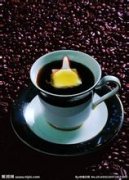A brief introduction to the description of the flavor and aroma characteristics of Uganda boutique coffee beans

But people who are used to drinking Chen beans are not used to the fresh taste, so they desperately pursue old Java coffee, so that the Indonesian government and some businessmen deliberately store fresh beans in warehouses for one or two years and then sell them to consumers. In fact, compared with fresh beans, the acidity of aged Java beans is close to zero, but the flavor is more intense. Because of the long storage time, the increase in cost and the limited quantity, Java has always been a hot item in the coffee market. In the 1880s, 0 merchants deliberately tampered with some fresh Guatemalan or Venezuelan beans to imitate aged Java for high prices. It is intolerable that 0 merchants dye coffee beans to make them look more like old Java, but there is no doubt that the dyed chemicals are certainly toxic.
Java produces only a small amount of Arabica beans, most of which were imported from Africa after the rust disaster. This coffee has a strong bitter taste after roasting, but the flavor is extremely light, although the acidity is low and the taste is delicate, it is rarely used for direct drinking, and is often used to mix mixed coffee, or to make instant coffee Mbale in the Elgang Mountains on the east side and other producing areas in the west near the border of the Democratic Republic of Congo, under the export name Wugar. The official ranks are Oaganic (Organic), BugisuAA, BugisuA, BugisuB, Bugisu PB, Wugar, Drugar and other unlisted grades. To find Ugandan coffee with good performance, you must first recognize the three grades of BugisuAA, An and PB, but because the country is inland and has many transportation problems, it often comes to raw beans with low moisture content and not emerald green appearance, but Ugandan coffee is not a type of coffee that emphasizes aroma, as long as the raw beans are not and turn 100 or yellowed, they can generally have a good flavor performance in the producing areas. It has a low ripe fruit aroma, such as the taste of red wine, and a thick mellow thickness, which is similar to some Kenyan beans with low tonality, but with a mild soil flavor, so it is quite different from other East African countries in flavor characteristics. on the contrary, it is a bit similar to Asia, Indonesia, Sulawesi? Tonaga coffee and Java state-owned manor coffee. The baking degree between City+ and Full City+ is all better.
At that time, Java coffee sold to Europe was a very special kind of coffee. At that time, it was shipped to Europe and the United States by sailboat, and the distance was long and the speed was slow, so it took a lot of time to transport. In this case, the coffee seems to have undergone a special fermentation and has a very unique taste.
Later, when the ship replaced the sailboat, due to the shortened delivery time, people drank relatively fresh coffee beans. But people who are used to drinking Chen beans are not used to the fresh taste, so they desperately pursue old Java coffee, so that the Indonesian government and some businessmen deliberately store fresh beans in warehouses for one or two years and then sell them to consumers. In fact, compared with fresh beans, the acidity of aged Java beans is close to zero, but the flavor is more intense. Because of the long storage time, the increase in cost and the limited quantity, Java has always been a hot item in the coffee market. In the 1880s, 0 merchants deliberately tampered with some fresh Guatemalan or Venezuelan beans to imitate aged Java for high prices. It is intolerable that 0 merchants dye coffee beans to make them look more like old Java, but there is no doubt that the dyed chemicals are certainly toxic.
Java produces only a small amount of Arabica beans, most of which were imported from Africa after the rust disaster. This coffee has a strong bitter taste after roasting, but the flavor is extremely light. Although the acidity is low and the taste is delicate, it is rarely used to drink directly. It is often used to mix mixed coffee, or to make instant coffee, Mbale on the east side of Mount Elgon and other producing areas on the west near the border of the Democratic Republic of Congo, under the export name Wugar. The official ranks are Oaganic (Organic), Bugisu AA, Bugisu A, Bugisu B, Bugisu PB, Wugar, Drugar and other unlisted grades. To find a good Ugandan coffee, you must first recognize the BugisuAA, An and PB grades, but because the country is inland and has many transport problems, it often comes to raw beans with low moisture content and not green appearance. However, Ugandan coffee is not a type of coffee that emphasizes rising aroma, as long as the raw beans are not and turn 100 or yellowed, they can generally have a good flavor in the producing area, with a low ripe fruit aroma, such as the taste of red wine, and thick mellow thickness. it is similar to some Kenyan beans with low flavor, but it also has a mild soil flavor, so it is quite different from other East African countries in flavor characteristics. On the contrary, it is somewhat similar to Asian Indonesian Sulawesi Tonaga coffee and Java manor coffee. The baking degree between City+ and Full City+ is all better.
Ugandan coffee beans have a unique flavor of delicate flavor, which is very suitable for making Italian and other flavors of coffee. More importantly, Ugandan coffee beans are strictly screened according to the standards of the international market to ensure their high quality and pollution-free characteristics.
The cultivation of Ganda Coffee is all small-scale family operation. The livelihood of 25% of the population is closely related to coffee production. About 500000 farms grow coffee, but mainly Robster. Robusta accounts for 90% of coffee production, and the remaining 1 is Arabica coffee. Arabica and Robusta are harvested from October to February.
Ugandan coffee is mainly exported to the European Union, in which Germany, Italy and other countries are the largest coffee buyers, Uganda coffee beans have a unique flavor of taste, which is very suitable for making Italian and other flavors of coffee. more importantly, Ugandan coffee beans are strictly screened in accordance with the standards of the international market to ensure their high-quality and pollution-free characteristics.
Africa is the hometown of the two major varieties of coffee, Arabica and Robusta, while Uganda, which is located in eastern Africa, which is known as "plateau water hometown" and "Pearl of East Africa", is believed by many to be the birthplace of Robusta.
Uganda is one of the few countries in the world that can grow both Arabica and Robusta, with an environment and climate suitable for coffee growth. Uganda is located between 9-2000 meters above sea level, with an annual temperature of 15 ℃-28 ℃.
Ugandan coffee beans have a unique flavor of delicate taste, which is very suitable for making Italian and other flavors of coffee. More importantly, Ugandan coffee beans are strictly screened according to the standards of the international market to ensure their high quality and pollution-free characteristics. Later, when ships replaced sailboats, people drank relatively fresh coffee beans due to shorter shipping time.
Important Notice :
前街咖啡 FrontStreet Coffee has moved to new addredd:
FrontStreet Coffee Address: 315,Donghua East Road,GuangZhou
Tel:020 38364473
- Prev

A brief introduction to the treatment method of grinding degree and baking degree of Ecuadorian boutique coffee beans with fresh taste
However, as the land suitable for Arabica coffee trees is decreasing, the production of Robbins coffee is gradually increasing. The best Arabica coffee comes from the Andes, especially the ChanchamgoValley, which is divided into two mountains, extending from south to north to central Ecuador. When it comes to Ecuadorian coffee, Ecuador Gallas has to be mentioned.
- Next

A brief introduction to the history and culture of the origin and development of fresh-flavored Ugandan boutique coffee beans
Most of Uganda is located in the Central African Plateau, with lakes, with an average elevation of 1000 mi 1200 meters. There are many lakes and plateaus in the mountains, which are known as the water villages of the plateau. The western branch of the East African Rift Valley runs through the western border, with many rivers and lakes at the bottom of the valley. Uganda has a great Victoria lake, coupled with the high mountains, which makes Uganda a mild climate suitable for growing coffee, although it spans both sides of the equator. Right and wrong in Uganda
Related
- Detailed explanation of Jadeite planting Land in Panamanian Jadeite Manor introduction to the grading system of Jadeite competitive bidding, Red bid, Green bid and Rose Summer
- Story of Coffee planting in Brenka region of Costa Rica Stonehenge Manor anaerobic heavy honey treatment of flavor mouth
- What's on the barrel of Blue Mountain Coffee beans?
- Can American coffee also pull flowers? How to use hot American style to pull out a good-looking pattern?
- Can you make a cold extract with coffee beans? What is the right proportion for cold-extracted coffee formula?
- Indonesian PWN Gold Mandrine Coffee Origin Features Flavor How to Chong? Mandolin coffee is American.
- A brief introduction to the flavor characteristics of Brazilian yellow bourbon coffee beans
- What is the effect of different water quality on the flavor of cold-extracted coffee? What kind of water is best for brewing coffee?
- Why do you think of Rose Summer whenever you mention Panamanian coffee?
- Introduction to the characteristics of authentic blue mountain coffee bean producing areas? What is the CIB Coffee Authority in Jamaica?

